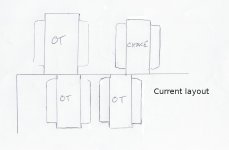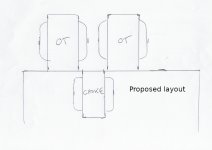I have an amp remodel project. The current physical configuration has the power supply choke mounted on the top of the chassis, and two output transformers mounted inside the chassis. i am remodeling such that I'll be using two larger OTs which will not fit underneath. They need to go on top, but it will be mighty crowded or possibly not doable if I keep the choke on top without making a new plate for remounting the rectifier tubes and can cap as well.
If reasonable I'd rather relocate the choke underneath where the OTs were.
Is there any problem with relocating the choke where the existing OTs are located inside the chassis?
If reasonable I'd rather relocate the choke underneath where the OTs were.
Is there any problem with relocating the choke where the existing OTs are located inside the chassis?
Can you post some photos? If you mount the choke directly below an output transformer,
it could cause some hum in that channel.
it could cause some hum in that channel.
The distance between choke and output transformers;
and the relative angular orientation of the choke and output transformers are important in order to reduce the occurence of hum.
A choke input B+ filter will cause a larger magnetic hum field, than a capacitor input B+ filter.
For a magnetic steel chassis, the choke hum will couple to the output transformers, especially more so if the OPTs are Single Ended (air gapped).
A non air gapped parafeed output transformer will respond to the choke's magnetic hum field more like a push pull non-air gapped output transformer.
Be sure to measure the hum before you modify the amplifier.
Hum comes from many different places:
Ground Loops
Badly filtered B+
Directly heated filaments that are powered with AC (not DC powered)
Other causes
If you do not measure before modification, how will you know if the hum is from the modification, or whether it was already there?
Your mileage may vary.
and the relative angular orientation of the choke and output transformers are important in order to reduce the occurence of hum.
A choke input B+ filter will cause a larger magnetic hum field, than a capacitor input B+ filter.
For a magnetic steel chassis, the choke hum will couple to the output transformers, especially more so if the OPTs are Single Ended (air gapped).
A non air gapped parafeed output transformer will respond to the choke's magnetic hum field more like a push pull non-air gapped output transformer.
Be sure to measure the hum before you modify the amplifier.
Hum comes from many different places:
Ground Loops
Badly filtered B+
Directly heated filaments that are powered with AC (not DC powered)
Other causes
If you do not measure before modification, how will you know if the hum is from the modification, or whether it was already there?
Your mileage may vary.
Can you post some photos? If you mount the choke directly below an output transformer,
it could cause some hum in that channel.
The amp is currently three channel, I am converting to two channel.
The current configuration of the iron:
-All cores are parallel
-On top sit an OT and the choke, about 3/4" apart from each other, This OT is larger as the channel is higher wattage
-Underneath are two OTs
Proposed new layout, choke underneath, OTs on top as shown. It would be more trouble, but I could also rearrange so that OTs would be moved left to the edge of the chassis, and the choke moved right underneath such that the choke's core would be completely offset to the side rather than in between the OTs
Attachments
Last edited:
The distance between choke and output transformers;
and the relative angular orientation of the choke and output transformers are important in order to reduce the occurence of hum.
A choke input B+ filter will cause a larger magnetic hum field, than a capacitor input B+ filter.
For a magnetic steel chassis, the choke hum will couple to the output transformers, especially more so if the OPTs are Single Ended (air gapped).
A non air gapped parafeed output transformer will respond to the choke's magnetic hum field more like a push pull non-air gapped output transformer.
Be sure to measure the hum before you modify the amplifier.
Hum comes from many different places:
Ground Loops
Badly filtered B+
Directly heated filaments that are powered with AC (not DC powered)
Other causes
If you do not measure before modification, how will you know if the hum is from the modification, or whether it was already there?
Your mileage may vary.
-There is no current hum problem
-It is a steel chassis
-The OTs are PP
-I will not be re-arranging grounds
-I am not changing the B+ filtering
-I am not changing the filament supply
-I am not redesigning a thing in terms of the circuitry. I am however converting two lower power channels into a single duplicate of the already existing higher wattage channel for a stereo pair. This is accomplished with the already existing tubes. Nothing added in that regard.
Last edited:
Can you move the choke closer to the power transformer, or at least have the choke at 90deg to the OT?
Coil axis is what matters, can be at right angles with cores parallel. But since this likely a smoothing choke, it won't have much 120 Hz field anyway.
- Home
- Amplifiers
- Tubes / Valves
- Question about relocating choke inside amp chassis

